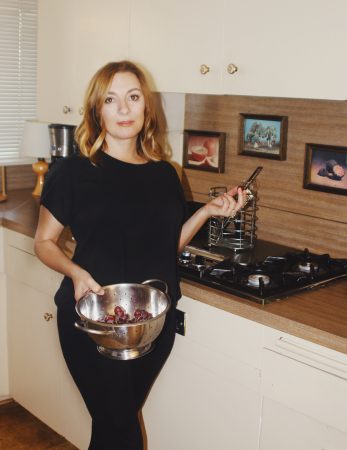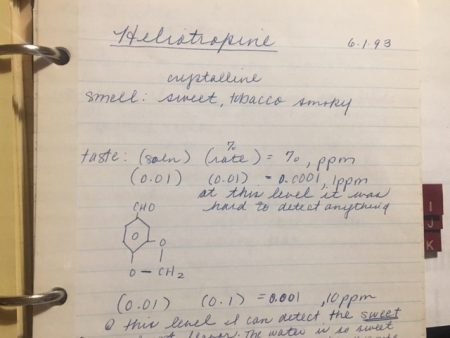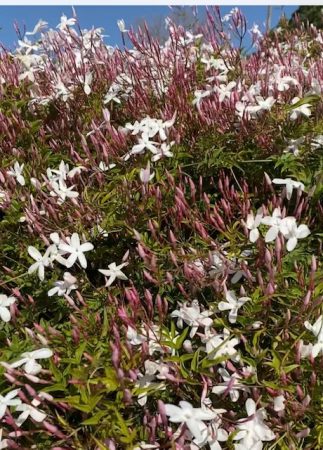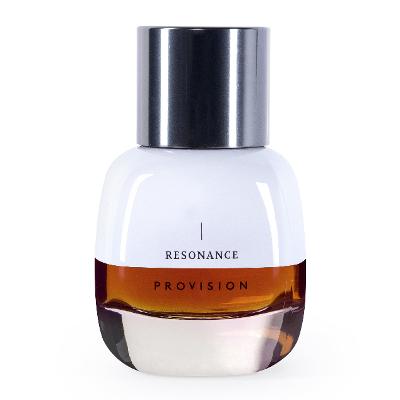
Sherri Sebastian of Provision Scents in her kitchen enjoying the taste of methyl anthranilate. (aka grapes)
Back in the 90’s when I was an apprentice perfumer at International Flavors and Fragrances, I would occasionally meet up with an old college friend who worked across the street at CBS. We’d catch up over a quick bite on the corner, rarely talking about work, typically sticking to our common interest in music, and most importantly which bands were playing when and where. One day I was wearing an experimental scent when I off-handedly mentioned that I needed to “make it happy on top,” turning back to our conversation without further explanation. My friend stopped me and asked, “Wait, what did you say?” “You mean ‘Make it happy on top?’” I asked, realizing as I said it again how funny it must have sounded. Until that point, it hadn’t occurred to me that there are many dialects spoken by and between perfumers about fragrances, aside from the more commonly spoken consumer-friendly descriptors like floral, fruity, spicy, vanilla, green, and so on. This memory got me thinking about how perfumers talk to each other about fragrances, as well as how I think about them. I have an ongoing and internal scent dialogue that’s always with me, whether I’m crafting the perfect top note to a new scent I’m working on, or just walking down the street.

Walking under a fig tree canopy and that aroma sounds better than “hmmm I smell gamma decalctone”
Case in point: For many months, I couldn’t figure out why I smelled gamma decalactone every time I passed by a particular house in my Los Angeles neighborhood. I wondered – are they burning fig candles 24/7? One day, I looked up as I passed by and realized I was walking under a fig tree! It seemed so obvious once I looked up, but it a was a scent moment I’d definitely never have experienced in PA or NY. Before I studied perfumery, I was an apprentice flavor chemist. Each morning upon entering the lab, I would begin to evaluate a new ingredient. I was taught to keep a journal of my ingredient studies where I would first write my own personal impression of the aroma. Reviewing these journals today brings back many memories with very interesting personal impressions, such as: burnt electrical wires, Kool-Aid, Band-Aid smell, baby doll head, swimming pool, horse stall, sweaty horse, bales of hay, garage oil, etc. (Did I mention I grew up in the country?)

Old school notes on an old school ingredient from the Notebook of Sherri Sebastian of Provision Scents.
As it turns out, these descriptors and dialects ended up serving me very well throughout my two-decade career as a professional perfumer. I could always memorize a chemical name like “methyl para cresol,” but I will never forget the scent of brushing a sweaty horse as a ten-year-old. Linking an ingredient with a personal experience makes for unforgettable linguistic scent descriptors. So when I later learned how important this “sweaty horse” ingredient can be to certain floral compositions, it was my own internal association that allowed me to translate this note into “correct perfumery talk” instead saying “animalic” when speaking to a fellow perfumer about this ingredient, that could turn a floral note decidedly jasmine.

Sweaty horse notes transformed into animalic pink jasmine.
It’s the same reason that when speaking to another perfumer I might recommend adding aldehyde C16 and they will automatically know I’m suggesting to increase the fruity aspect of strawberry, even though in my own mind I might be thinking “add more of a baby doll plastic note.” (Anyone remember Strawberry Shortcake dolls?) This ability to toggle between the deeply personal, industry-insider, and outward facing fragrance dialect is especially valuable when I’m working with a brand to create a new scent for their products. This is why I always encourage anyone I’m working with to skip the “marketing descriptors” or “perfume terms” when trying to explain what they’re looking for, and speak in plain terms about their own desired experience. Through these conversations I can learn a lot more about how each person experiences scent and have a better chance at making a good translation. I’ve learned that a big part of being a good perfumer is to be a good translator of the many scent dialects. I’m excited to share more about the new scents I’m developing and reveal more about how this process is unfolding.
In the meantime, I ask you to develop your own inner dialect about the scents you encounter throughout the day. As you become more attuned with your own fragrance talk, you will have a greater opportunity to find what you like with ease, regardless of the words used.
—Sherri Sebastian, Contributing Editor and perfumer for Provision Scents, all photos by Sherri Sebastian©
Sherri Sebastian is an independent perfumer and founder of luxury wellness brand, Provision Scents provisionscents.com She’s based in Los Angeles and is the Vice President of the American Society of Perfumers.
Please like The Series on Facebook here and your comment will count twice

Provision Scents Resonance (Sherri’s personal descriptor is “Daniel” it is her husband’s favorite
Thanks to Provision Scents and perfumer Sherri Sebastian there is a draw for a USA registered CaFleureBon reader (if you are not sure if you are registered click here (you must register on our site or your entry will be invalid) for a bottle of Provision Scents Resonance. To be eligible please leave a comment with what you enjoyed or learned from Sherri’s article on personal perfume descriptors. Do you think of scent in terms of “marketing notes and descriptors” or aromas you are familiar with? Draw closes 10/7/2020
all photos Sherri Sebastian©
Please like The Series on Facebook here and your comment will count twice
You can follow us @cafleurebon @provisionscents @sherri_sebastian on Instagram.
This is our Privacy and Draw Rules Policy
We announce the winners only on site and on our Facebook page, so Like ÇaFleureBon and use our blog feed … or your dream prize will be just spilled perfume
